HDX Enlightened Data Transport (HDX Adaptive Transport) is a new HDX virtual channel data transport engine now in general release that is designed to combat challenging WAN access to published applications and desktops. Think scenarios where your resources are placed on public cloud or you simply have access back to the datacentre hosting your Citrix resources, with WAN performance that may be limited due to forms of small packet loss and high latency. With this being said, HDX EDT is just as good for handling connections inside the corporate LAN.
This new data delivery method boosts performance of all ICA channels (apart from Framehawk and RTP Audio) such as your Thinwire display protocols (ThinWire+, H.264), printing, client drive mapping (file transfers), audio and video.
One common misconception around EDT is that bandwidth consumption is reduced. This isn’t necessarily true. Traffic will reach the destination quicker which will result in a better user experience. EDT however can consume more bandwidth than TCP, especially when used across high bandwidth lines with or without small amounts of packet loss and used for heavy processing (non-Task Workers). On low latent lines the different in bandwidth consumption between TCP and UDP is barely noticeable.
You are probably aware that Framehawk (deprecated in Virtual Apps and Desktops 1811) was released on Citrix XenApp and XenDesktop 7.6 FP2+ and that protocol runs over UDP instead of TCP such as ICA TCP 1494 or Session Reliability TCP 2598. I did my own testing of Framehawk and found that it could fight back against some really high latent WAN links, even providing good experience during packet loss. Some of the techniques used with Framehawk have been selected and used with this new transport engine.
Note: Session Reliability is required when routing Adaptive Transport via NetScaler Gateway. It is not required however when using Adaptive Transport for internal connections.
Note: HDX Enlightened Data Transport is generally available in XenApp/XenDesktop 7.13. It is the default transport method on 7.16.
Note: This technology is currently available also through NetScaler firmware 11.1 build 51.21 and above. DTLS must be enabled on the NS Gateway vServer to encrypt the UDP packets. See http://docs.citrix.com/en-us/netscaler-gateway/11-1/hdx-enlightened-data-transport-support/configuring-netscaler-gateway.html
Note: DTLS will be enabled by default on NetScaler 12.x appliances released in Q4 2017.
To enable HDX Enlightened Data Transport you need configure a Citrix policy setting, specifically the HDX Enlightened Data Transport setting which contains the following options:
- Off – This is simply off and you will continue to use TCP 1494 or TCP 2598 as normal.
- Preferred – HDX Data Transport engine uses UDP as preferred, with fallback to TCP.
- Diagnostic Mode – Fallback to TCP is disabled.

Note: In Citrix XenApp and XenDesktop 7.16, HDX Enlightened Data Transport is Preferred by default.
What else is required?
- XenApp or XenDesktop 7.13+
- Server OS or Desktop OS VDA 7.13+
- StoreFront 3.8+
- Citrix Receiver 4.6+ for Windows
- Citrix Receiver 12.4+ for Mac
- Citrix Receiver for iOS 7.2+
- Citrix Receiver for Linux 13.6+. Direct connections only. Version 13.7+ released NetScaler Gateway support.
- Citrix Receiver for Android 3.12+ direct connections only. Version 3.13+ released NetScaler Gateway support.
Note: IPv4 VDAs only at this time. No IPv6/mixed VDAs.
The first thing I’ll do is specify HDX Enlightened Data Transport = Preferred inside a Citrix policy. I’ve not opened UDP 1494 or 2598 so the session falls back to TCP 2598 using Session Reliability. We can confirm that by launching a session (it connects which is a obviously a good sign) and launching CMD. Next change directory to C:\Program Files (x86)\Citrix\System32. Now run CtxSession. You can see that TCP is being used with CGP (Session Reliability) and Session Reliabilty encapsulates the ICA protocol.![]()
Run CtxSession /v for a verbose output. Here you can see the port 2598 being used on the VDA.  Next with UDP 1494 and 2598 ports open on the VDA I connect back to the Citrix desktop, run CtxSession /v and receive confirmation that we are now using UDP 2598. This means that HDX Enlightened Data Transport is being used with Session Reliability. You can also check Director and note the protocol will be set as UDP.
Next with UDP 1494 and 2598 ports open on the VDA I connect back to the Citrix desktop, run CtxSession /v and receive confirmation that we are now using UDP 2598. This means that HDX Enlightened Data Transport is being used with Session Reliability. You can also check Director and note the protocol will be set as UDP.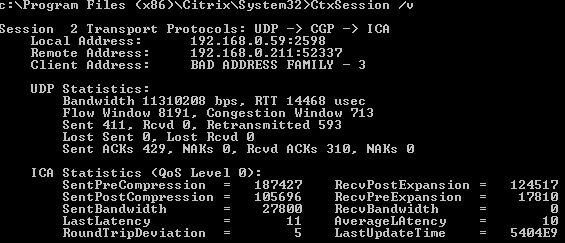 At this stage we are ready to do some file transfer testing!
At this stage we are ready to do some file transfer testing!
First up I am copying a 45MB file across the VDA client drive mapping virtual channels. Nothing is tweaked, simply using TCP 2598 to perform the first copy on a network with low latency. And then UDP with the HDX data transport engine to perform the second copy.
And then UDP with the HDX data transport engine to perform the second copy.  Similar copy times, nothing major going on here but gives a baseline.
Similar copy times, nothing major going on here but gives a baseline. 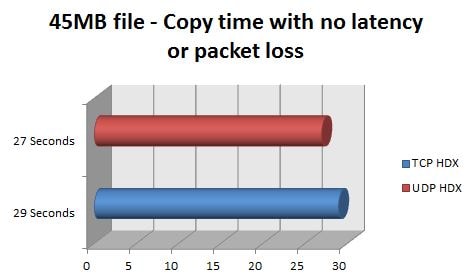 The second copy is on a link with 100ms latency. The first copy is TCP ICA 2598.
The second copy is on a link with 100ms latency. The first copy is TCP ICA 2598.  The second copy is using UDP. A generally higher average speed is captured using UDP.
The second copy is using UDP. A generally higher average speed is captured using UDP.  UDP copies the file twice as fast as TCP! Remember this is over a 100ms line. 43 seconds is rather impressive and shows the potential of this new delivery method.
UDP copies the file twice as fast as TCP! Remember this is over a 100ms line. 43 seconds is rather impressive and shows the potential of this new delivery method. 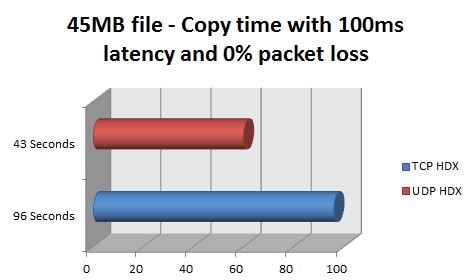 The next copy compares 100ms latency to 200ms. Remember the 100ms copy took 43 seconds, the 200ms copy takes 60 seconds. Even though we added an extra 100ms round-trip latency to the line the results show a copy of a 45MB file over a 200ms line is still an incredible 36 seconds faster than the 100ms TCP copy.
The next copy compares 100ms latency to 200ms. Remember the 100ms copy took 43 seconds, the 200ms copy takes 60 seconds. Even though we added an extra 100ms round-trip latency to the line the results show a copy of a 45MB file over a 200ms line is still an incredible 36 seconds faster than the 100ms TCP copy. 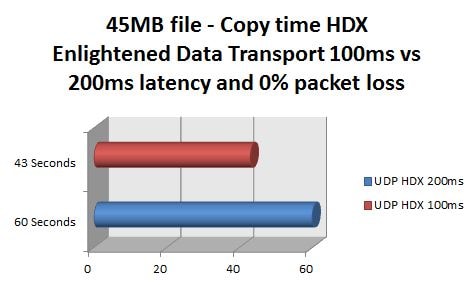 How about 300ms? Just to confirm, look at that awful latency.
How about 300ms? Just to confirm, look at that awful latency. ![]() Citrix Director showing the high latency also. At this stage TCP is barely able to cope and I abandon any thoughts of file copy testing using TCP altogether.
Citrix Director showing the high latency also. At this stage TCP is barely able to cope and I abandon any thoughts of file copy testing using TCP altogether.  However, UDP keeps going on by copying a 45MB file over a 300ms line in 79 seconds. Yes, it STILL is faster than TCP on a 100ms line. Also note we are seeing some linear scalability here, as each 100ms of latency added on is seeing roughly a 15-20 second increase in copy times.
However, UDP keeps going on by copying a 45MB file over a 300ms line in 79 seconds. Yes, it STILL is faster than TCP on a 100ms line. Also note we are seeing some linear scalability here, as each 100ms of latency added on is seeing roughly a 15-20 second increase in copy times.
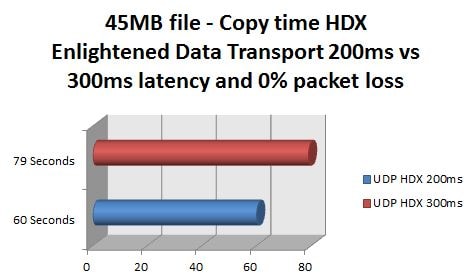 Let’s add some packet loss and reduce the latency. We are back down to 100ms-200ms latency but with 1% packet loss. This is the UDP copy over 100ms latency and 1% packet loss.
Let’s add some packet loss and reduce the latency. We are back down to 100ms-200ms latency but with 1% packet loss. This is the UDP copy over 100ms latency and 1% packet loss.  And the 200ms latency 1% packet loss copy. The throughput is slighly less as expected.
And the 200ms latency 1% packet loss copy. The throughput is slighly less as expected.  A 45MB file copy over 100ms line with 1% packet loss takes 117 seconds. You need to wait 23 more seconds when copying over a 200ms line.
A 45MB file copy over 100ms line with 1% packet loss takes 117 seconds. You need to wait 23 more seconds when copying over a 200ms line. 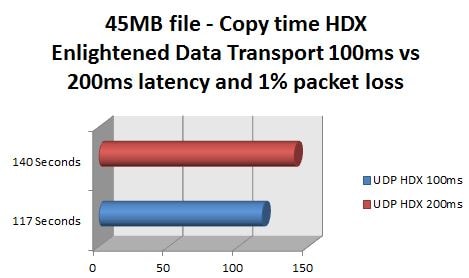 The next set of tests are video based, playing a 30 second YouTube video and recording the throughput both using TCP and UDP. ThinWire+ was used during testing, H.264 was completely disabled.
The next set of tests are video based, playing a 30 second YouTube video and recording the throughput both using TCP and UDP. ThinWire+ was used during testing, H.264 was completely disabled.
On the first test over 200ms both protocols play back the video quite well. Not any difference in results. At 400ms HDX data transport starts to make ground on TCP. The video over TCP is pretty much unwatchable.
At 400ms HDX data transport starts to make ground on TCP. The video over TCP is pretty much unwatchable. 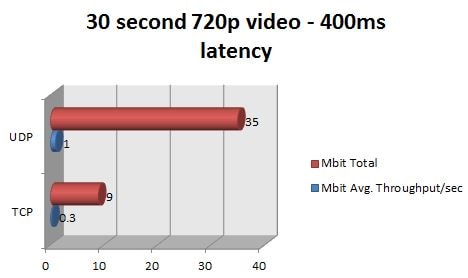 600ms latency on UDP gets more throughput than TCP running over 400ms latency. Whilst both videos are barely watchable it’s good to know that HDX Enlightened Data Transport punches at a higher weight.
600ms latency on UDP gets more throughput than TCP running over 400ms latency. Whilst both videos are barely watchable it’s good to know that HDX Enlightened Data Transport punches at a higher weight. 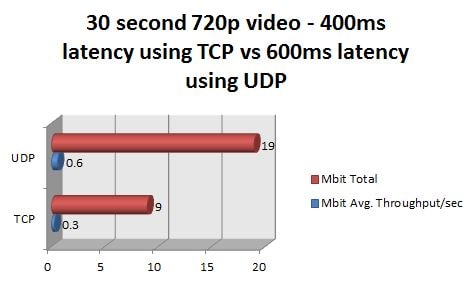 Marius has also wrote a good blog article on this new protocol around the networking level and how we can fallback to TCP during the middle of a session http://msandbu.org/benchmarking-adaptive-transport-for-hdx/
Marius has also wrote a good blog article on this new protocol around the networking level and how we can fallback to TCP during the middle of a session http://msandbu.org/benchmarking-adaptive-transport-for-hdx/
Mayunk Jain
December 13, 2016This is great stuff, George. Added a link to this post in the Discussion Forum for this tech preview, to help others who may be interested. Feel free to add more results and comments as you continue testing.
Mayunk
Tech Marketing, HDX
George Spiers
December 13, 2016Thanks Mayunk.
I am open to testing requests if anyone has any. I’ll think of other tests that are easily showcased.
Pingback: Benchmarking Adaptive Transport for HDX | Marius Sandbu
Vishal Ganeriwala
December 13, 2016George,
This is good work and excellent data for the community. Are you going to be at Citrix Summit? Let’s meet up
George Spiers
December 14, 2016Vishal unfortunately I won’t be there. I could end up at Synergy, I’ll have to wait and see!
Vishnu
October 13, 2023Hi,
If we are using Citrix workspace, if we need to use EDT in client machine, what are the changes required?
Pingback: EUC Weekly Digest – December 17, 2016 – Carl Stalhood
Samer
June 26, 2019Hi George,
I am stuck at the end to end EDT thing. I have done everything mentioned by book internally and on NetScaler. However i am not able to establish a DTLS through the receiver accessing the VDAs.
Can you please help me with this ?
Regards,
Samer.
George Spiers
June 27, 2019Just to check, you can make an EDT connection internally but not externally?
Things to check:
Enable DTLS on the Gateway vServer.
Open EDT ports on external firewalls.
Make sure Session Reliability is enabled on the StoreFront Store you use with Gateway.
Michael
September 13, 2019I’ve been working through this recently. I found that I needed to set the MTU configuration on the ICA file in order for everything to go through UDP. It would always fall back to TCP until i dropped the MTU down – https://support.citrix.com/article/CTX231821
Pingback: Citrix Troubleshooting 101: Frequently Asked Questions | eG Innovations
Pingback: 8 Citrix Virtual Apps & Desktops Policies | eG Innovations
Pingback: Citrix Troubleshooting Guide & FAQs | eG Innovations
erk
July 16, 2020Hi George, Does this mean we no longer have to set the XA_XD profile on the Gateway VServer or is there an equivalent for UDP?
Pingback: Citrix Troubleshooting Steps – eG Innovations
Barry
February 19, 2021This was very useful, thanks
Anonymous
September 18, 2023Always Great content!! Thanks George..